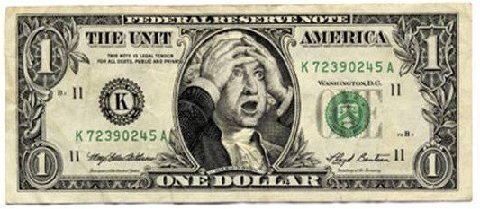Past events, no matter how horrible, can be instructive reminders about where we are today. This week marks the fifteenth anniversary of the 9-11 attacks, which helps me think about the people I knew who perished that frightful day. The anniversary also serves as a gut check about something we know, but don’t like to dwell on: bad things can happen at any time, so we better enjoy what we have today or at least try to make a plan to change what we don’t like. We are also approaching the eighth anniversary of the financial crisis, which brought the U.S. financial system to its knees. From September 15 - 21 2008, four investment banks were gone (Lehman Brothers went broke, Merrill Lynch was purchased at a fire sale by Bank of America and Morgan Stanley and Goldman Sachs were forced to become bank holding companies); global insurance giant AIG was bailed out; the money market fund industry was rocked after the net asset value of shares in the Reserve Primary Money Fund fell below $1 per share; and the Treasury Department introduced the first version of TARP, which granted authority to purchase $700 billion of mortgage-related assets for two years.
Thankfully, those dark days are behind us, but for those still worried about the financial system, Moody’s Analytics notes, “Since the financial crisis, the banks have raised substantial amounts of capital, significantly improved their liquidity, and vastly upgraded their risk management practices…It is also reassuring that regulators appear to be carefully monitoring the financial system, and willing and able to take action to head off problems before they become existential economic threats.”
Both during and after the crisis, the Federal Reserve played an active role in helping to stabilize the financial system. In addition to slashing interest rates, it embarked on three versions of bond buying, which were intended to stimulate economic growth. Some believe that the Fed’s action helped save the U.S. economy, but eight years hence, the reversal of those strategies are causing consternation. Friday’s stock market rout was an excellent case in point.
The cause of the selloff, according to the financial media, was a statement by Boston Fed President Eric Rosengren, who said “a reasonable case can be made” for tightening interest rates to avoid overheating the economy. Additionally, a previously unannounced speech by Fed Governor Lael Brainard on Monday (a day ahead of the Fed’s blackout period on giving public comment before its upcoming meeting) got the rumor mill swirling.
Are these two previously dovish Fed officials getting out in front of the public to signal a potential rate hike at the Fed’s policy Sep 20-21 policy meeting? Never mind that recent manufacturing data has been terrible, job growth slowed in August and core retail sales were weak in July. The likelier scenario for the Friday selloff is a more reasonable one articulated by a hedge fund manager I know: “Both stocks and bonds are relatively expensive right now…any suggestion that two dovish Fed officials’ spurring the selloff seems more like a bug looking for a windshield.”
Federal Governor Daniel Tarullo seems to agree. He told CNBC on Friday he wants to see more evidence of sustained inflation before considering an interest rate increase and currently, “We're not running a hot economy.” However, Tarullo also acknowledged “There's no question...when rates are low for a long time that there are opportunities for frothiness and perhaps over-leverage in particular asset markets.”
In other words, when rates stay so low for so long, investors look past fundamentals, drive prices higher and can become complacent. One sign of that complacency can be seen in the VIX index, which is a measure of the expected swings in the S&P 500 over the next thirty days. Recently, the 30 day annualized volatility (of daily changes) in the S&P 500 fell to its lowest level since 1994.
Friday’s selling may simply be an proof that people periodically remember that the risks they previously accepted, may no longer feel so great, especially considering the age of the bull market. But as the analysts at Capital Economics note, “The fact that volatility was low in the mid-1990s did not preclude equity prices from rising for several years as a bubble inflated.”
MARKETS: Stocks tumbled 2.5 percent on Friday, pushing indexes down on the week.
- DJIA: 18,085, down 2.2% on week, up 3.8% YTD
- S&P 500: 2127, down 2.4% on week, up 4.1% YTD
- NASDAQ: 5125, down 2.4% on week, up 2.4% YTD
- Russell 2000: 1219, down 1.5% on week, up 7.3% YTD
- 10-Year Treasury yield: 1.68% (from 1.63% week ago), highest level since June 23, the day of the Brexit vote
- British Pound/USD: 1.3262
- October Crude: $45.88
- December Gold: at $1,334.50
- AAA Nat'l avg. for gallon of reg. gas: $2.18 (from $2.21 wk ago, $2.37 a year ago)
THE WEEK AHEAD:
Mon 9/12:
Tues 9/13:
6:00 NFIB Small Business Optimism Index
Weds 9/14:
8:30 Import and Export Prices
Thursday 9/15:
8:30 PPI
8:30 Retail Sales
8:30 Empire State Mfg Survey
8:30 Philadelphia Fed Business Outlook
9:15 Industrial Production
10:00 Business Inventories
Friday 9/16:
8:30 CPI
10:00 Consumer Sentiment
![Jill on Money [ Archive]](http://images.squarespace-cdn.com/content/v1/59efbd48d7bdce7ee2a7d0c4/1510342916024-TI455WZNZ88VUH2XYCA6/JOM+Blue+and+White.png?format=1500w)








